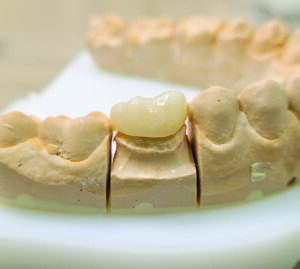Dental Crown

A straightforward method of treating a tooth cavity is through a dental filling. Nevertheless, if the cavity is extensive or the filling is being positioned in a high-stress area, there’s a risk that the filling material could become dislodged. In such cases, it’s advisable to explore the option of getting a dental crown.
A dental crown functions as a cap that is affixed to the tooth, offering complete protection from all angles. Due to its comprehensive coverage, it is also a recommended treatment for a cracked tooth, effectively preventing further cracking.
The dental crown procedure typically involves two visits:
The dentist reduce the size of the target tooth to create space for the future crown. Then, a dental impression is taken and sent to a dental lab, where a custom-made crown is fabricated.
Once the crown is ready, it is returned to the clinic. The dentist conducts a try-in of the crown, making adjustments if required. Subsequently, the crown is permanently cemented onto the prepared tooth.
Types of dental crown material:
- Full metal : Very strong as it is metal, but silver in colour
- Porcelain-fused-metal (PFM) : Layers of tooth-colour ceramic fused onto the metal frame, making it more esthetically pleasant than full metal crown
- Full ceramic : Fully made from tooth-coloured ceramic, boasting exceptional aesthetics, but not as strong.
- Full zirconia : Zirconia plate being trimmed into crown shape, very strong and tooth-coloured.
- Porcelain-fused-zirconia : Layers of tooth-colour ceramic fused onto the zirconia frame, excellent in strength and esthetics
Dental Bridge
A dental bridge is used to replace one or more missing teeth.
It consists of one or more artificial teeth, known as pontics, which are anchored in place by one or more crowns on each side.
The dental bridge helps restore the appearance of your smile, improve chewing and speaking abilities, and prevent adjacent teeth from shifting into the gap.
Types of dental bridge designs:

Conventional Bridge
The artificial tooth (pontic) is anchored in place by one or more crowns on each side.

Maryland Bridge
This type of bridge features a wing on each side of the artificial tooth. These wings are bonded to the adjacent natural teeth. Maryland bridges are primarily suitable for front teeth, where the biting force is relatively lower.

FRC bridge
Fibre-Reinforced Composite (FRC) Bridge is done in single appointment. Fibre will be bonded onto the anchor tooth, then the dentist will build up the artificial tooth using a composite. It is primarily suitable for front teeth.
FAQ
The tooth that will receive a crown will need to be trimmed. If the tooth is vital, local anesthetic will be administered to numb the tooth before beginning the trimming process. The dentist will ensure that only necessary trimming is performed to prevent the tooth from becoming painful after the appointment.
It is usually done in 2 visits:
- Tooth preparation + Dental impression
- Crown/bridge try-in, if no further modification is required, dentist will cement (glue) the crown/bridge onto the receipent tooth.
Patient usually have the crown/bridge completed within 10-14 days.
Dental crown or bridge is considered as fixed prostheses. Dentist will use a type of cement to permanently attach the prostheses onto the recepient tooth. There is no need to remove the prostheses during sleep.